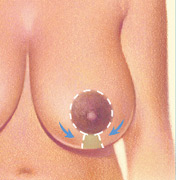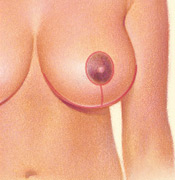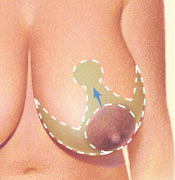Breast Reduction
What is Breast Reduction?
Overly large breasts can cause health and emotional problems. In addition to self image issues, you may also experience physical pain and discomfort. The weight of excess breast tissue can impair your ability to lead an active life. The emotional discomfort and self-consciousness often associated with having large pendulous breasts can be as important an issue as the physical discomfort and pain.
Breast reduction, also known as reduction mammaplasty, is a procedure to remove excess breast fat, glandular tissue, and skin to achieve a breast size in proportion with your body and to alleviate the discomfort associated with overly
large breasts.
Breast reduction is a good option for you if you:
- Are physically healthy
- Have realistic expectations
- Don't smoke
- Are bothered by feeling that your breasts are too large
- Have breasts that limit your physical activity
- Experience back, neck, and shoulder pain caused by the weight of your breasts
- Have shoulder indentations from bra straps
- Have skin irritation beneath the breast crease
Consultation and Preparing for Surgery
During your consultation be prepared to discuss:
- Your surgical goals
- Medical conditions, drug allergies, and medical treatments
- Current medications, vitamins, herbal supplements, alcohol, tobacco, and drug use
- Previous surgeries
- Family history of breast cancer and results of any mammograms or previous biopsies
Your surgeon will also:
- Evaluate your general health status and any pre-existing health conditions or risk factors
- Examine your breasts and may take detailed measurements on their size, skin quality, and location of your nipples and areolas
- Take photographs
- Discuss your options
- Recommend a course of treatment
- Discuss likely outcomes of breast reduction and any risks or potential complications
- Discuss the use of anesthesia during your breast reduction
Prior to surgery, you may be asked to:
- Get lab testing or a medical evaluation
- Take certain medications or adjust your current medications
- Provide the results of your most recent mammogram, or obtain a new mammogram if you are not up to date with recommended guidelines
- Stop smoking
- Avoid taking aspirin, anti-inflammatory drugs, and herbal supplements as they can increase bleeding
Breast reduction surgery may be performed in an accredited office-based surgical facility, licensed ambulatory surgical center, or a hospital. If your breast reduction is performed on an outpatient basis, be sure to arrange for someone to drive you to and from surgery and to stay with you for at least the first night following surgery.
Be sure to ask your plastic surgeon questions. It's very important to understand all aspects of your breast reduction. It's natural to feel some anxiety, whether it's excitement for your anticipated new look or a bit of preoperative stress. Don't be shy about discussing these feelings with your plastic surgeon.
The Procedure
Breast reduction involves making incisions on the breast skin to remove the excess breast tissue and skin.
In some cases, excess fat may be removed through liposuction in conjunction with the excision techniques described below. If breast size is largely due to fatty tissue and excess skin is not a factor, liposuction alone may be used for breast reduction.
The technique used to reduce the size of your breasts will be determined by your individual anatomy, breast composition, amount of reduction desired, your personal preferences and the surgeon's advice.
Step 1—Anesthesia
Medications are administered for your comfort during the surgical procedure. The choices include intravenous sedation and general anesthesia. Your doctor will recommend the best choice for you.
Step 2—The incision
Incision options include:
A keyhole or racquet-shaped pattern


An inverted T or anchor-shaped incision pattern


Step 3—Removing tissue and repositioning
After the incision is made, the nipple— which remains tethered to its original blood and nerve supply—is then repositioned. The areola diameter is reduced by excising skin at the perimeter, if necessary. Underlying breast tissue is reduced, and the remaining breast tissue is lifted and shaped. Rarely, in extremely large breasted women, the nipple and areola may need to be removed and repositioned to a higher position on the breast (free nipple graft).
Step 4—Closing the incisions
The incisions are brought together to reshape the now smaller breast. Sutures are layered deep within the breast tissue to create and support the newly shaped breasts; sutures, skin adhesives and/or surgical tape close the skin. Incision lines are permanent, but in most cases will fade and significantly improve over time.
The incision lines that remain are visible and permanent scars, although usually well concealed beneath a swimsuit or bra.
Risks and Safety
The decision to have breast reduction surgery is extremely personal. You will have to decide if the benefits will achieve your goals and if the risks and potential complications are acceptable. Although there is a fair amount of scarring associated with breast reduction surgery, it has one of the highest rates of satisfaction among procedures performed by plastic surgeons. Most women note significant improvement in their neck, back, and shoulder discomfort. They are more able to participate in athletic activities, and their clothing choices are liberalized.
Prior to undergoing breast reduction surgery, you will be asked to sign consent forms to ensure that you fully understand the procedure and any risks and potential complications.
The risks include:
- Allergies to tape, suture materials and glues, blood products, topical preparations, or injectable agents
- Anesthesia risks
- Bleeding
- Blood clots
- Breast asymmetry
- Breast contour and shape irregularities
- Changes in nipple or breast sensation, which may be temporary or permanent
- Deep vein thrombosis, cardiac and pulmonary complications
- Fluid accumulation
- Infection
- Persistent pain
- Poor wound healing
- Possibility of revisional surgery
- Potential inability to breastfeed
- Potential partial or total loss of nipple and areola
- Skin discoloration, and permanent pigmentation changes
- Unfavorable scarring
- Scarring within the breast tissue may cause firmness or lumps know as fat necrosis
These risks and others will be fully discussed prior to your consent. It's important that you address all of your questions directly with your plastic surgeon.
You should know that:
- Your ability to breastfeed following reduction mammaplasty may be limited; talk to your doctor if you are planning to nurse a baby
- The procedure can be performed at any age, but is best done when your breasts are fully developed
- Changes in the breasts during pregnancy can alter the outcomes of previous breast reduction surgery, as can significant weight fluctuations
Recovery After Surgery
After your breast reduction procedure is completed, dressings or bandages will be applied to the incisions. You'll need to wear an elastic bandage or support bra to minimize swelling and support your breasts as they heal. A small, thin tube may be temporarily placed under the skin to drain any excess blood or fluid that may collect.
You will be given specific instructions that may include how to care for your breasts following surgery, medications to apply or take orally to aid healing and reduce the potential for infection, specific concerns to look for at the surgical site or in your general health, and when to follow up with your plastic surgeon.
Be sure to ask your plastic surgeon specific questions about what you can expect during your individual recovery period.
- Where will I be taken after my surgery is complete?
- What medication will I be given or prescribed after surgery?
- Will I have dressings/bandages after surgery?
- When will they be removed?
- Are stitches removed? When?
- When can I resume normal activity and exercise?
- When do I return for follow-up care?
When you go home
If you experience shortness of breath, chest pains, or unusual heart beats, seek medical attention immediately. Should any of these complications occur, you may require hospitalization and additional treatment.
Results
The results of your breast reduction surgery are immediately visible. Over time, post-surgical swelling will resolve and incision lines will fade. Satisfaction with your new image should continue to grow as you recover from surgery. The final results of your breast reduction will appear over the next few months as breast shape and position continue to settle. Incision lines are permanent but will continue to fade over time.
The results of your breast reduction surgery will be long-lasting. However, your breasts can continue to change due to aging and gravity. You'll be able to retain your new look longer if you:
- Maintain your weight
- Keep a healthy lifestyle
Although good results are expected from your procedure, there is no guarantee. In some situations, it may not be possible to achieve optimal results with a single surgical procedure and another surgery may be necessary.
Following your physician's instructions is essential to the success of your surgery. It's important that the surgical incisions are not subjected to excessive force, swelling, abrasion, or motion during the time of healing. Your doctor will give you specific instructions on how to care for yourself.
Cost
Many health insurance plans cover breast reduction surgery. Your plastic surgeon may need to obtain authorization from your insurer for the surgery. This may require a letter and the submission of photographs. Once an authorization is obtained, you will be able to schedule your surgery. You will be responsible for any co-pays or deductible required by your insurer. If your health plan does not cover breast reduction, you may decide to pay for the surgery yourself. A surgeon's cost may be based on his or her experience, the type of procedure used, and the geographic location of the office. Your surgeon may offer patient financing plans, so be sure to ask.
Cost may include:
- Anesthesia fees
- Hospital or surgical facility costs
- Medical tests
- Post-surgery garments
- Prescriptions for medication
- Surgeon's fee
Your satisfaction involves more than a fee:
When choosing a plastic surgeon for breast reduction surgery, remember that the surgeon's experience and your comfort with him or her is just as important as the final cost of the surgery.
Plastic surgery involves many choices. The first and most important is selecting an ASPS member surgeon you can trust. ASPS member surgeons meet rigorous standards:
- Board certification by the American Board of Plastic Surgery® (ABPS) or in Canada by The Royal College of Physicians and Surgeons of Canada®
- Complete at least six years of surgical training following medical school with a minimum of three years of plastic surgery residency training
- Pass comprehensive oral and written exams
- Graduate from an accredited medical school
- Complete continuing medical education, including patient safety each year
- Perform surgery in accredited, state-licensed, or Medicare-certified surgical facilities
Do not be confused by other official sounding boards and certifications.
The ABPS is recognized by the American Board of Medical Specialties (ABMS), which has approved medical specialty boards since 1934. There is no ABMS recognized certifying board with "cosmetic surgery" in its name. By choosing a member of The American Society of Plastic Surgeons, you can be assured that you are choosing a qualified, highly trained plastic surgeon who is board-certified by the ABPS or The Royal College of Physicians and Surgeons of Canada.
This procedural information is intended strictly for educational purposes. Only models are depicted in these procedural information pages. It is not intended to make any representations or warranties about the outcome of any procedure. It is not a substitute for a thorough, in-person consultation with a board certified plastic surgeon.
